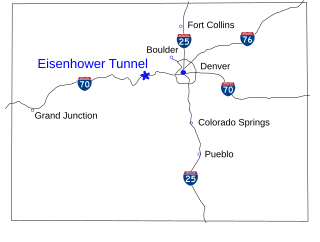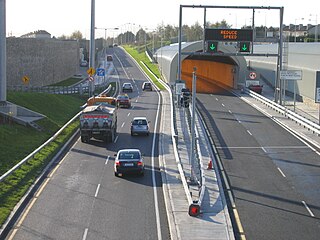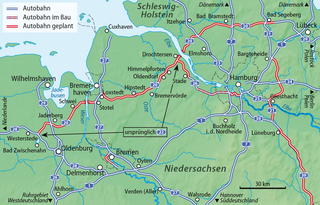
The Elbe is one of the major rivers of Central Europe. It rises in the Krkonoše Mountains of the northern Czech Republic before traversing much of Bohemia, then Germany and flowing into the North Sea at Cuxhaven, 110 kilometres northwest of Hamburg. Its total length is 1,094 km (680 mi).

The Eisenhower Tunnel, officially the Eisenhower–Edwin C. Johnson Memorial Tunnel, is a dual-bore, four-lane vehicular tunnel in the western United States, approximately 60 miles (97 km) west of Denver, Colorado. The tunnel carries Interstate 70 (I-70) under the Continental Divide in the Rocky Mountains. With a maximum elevation of 11,158 feet (3,401 m) above sea level, it is one of the highest vehicular tunnels in the world. The tunnel is the longest mountain tunnel and highest point on the Interstate Highway System. With the completion of the second bore in 1979, it was one of the last major segments of the Interstate system to be completed. Opened in 1973, the westbound bore is named after Dwight D. Eisenhower, the U.S. President for whom the Interstate system is also named. The eastbound bore was completed in 1979 and is named for Edwin C. Johnson, a governor and U.S. Senator who lobbied for an Interstate Highway to be built across Colorado.

The Gotthard Road Tunnel in Switzerland runs from Göschenen in the canton of Uri at its northern portal, to Airolo in Ticino to the south, and is 16.9 kilometres (10.5 mi) in length below the St Gotthard Pass, a major pass of the Alps. At time of construction, in 1980, it was the longest road tunnel in the world; it is currently the fifth-longest. Although it is a motorway tunnel, part of the A2 from Basel to Chiasso, it consists of only one bidirectional tube with two lanes. With a maximum elevation of 1,175 metres (3,855 ft) at the tunnel's highest point, the A2 motorway has the lowest maximum elevation of any direct north-south road through the Alps.

The Caldecott Tunnel is an east–west highway tunnel through the Berkeley Hills between Oakland and Orinda, California. Its four bores carry California State Route 24. Named after Thomas E. Caldecott, former mayor of Berkeley, it opened in 1937 as a two-bore tunnel. The third bore opened in 1964 and the fourth bore in 2013. Currently, the two oldest bores carry eastbound traffic and the two newest bores carry westbound traffic.

The Dublin Tunnel, originally and still commonly known as the Port Tunnel, is a road traffic tunnel in Dublin, Ireland, that forms part of the M50 motorway.

A reversible lane is a lane in which traffic may travel in either direction, depending on certain conditions. Typically, it is meant to improve traffic flow during rush hours, by having overhead traffic lights and lighted street signs notify drivers which lanes are open or closed to driving or turning.

Bundesautobahn 7 is the longest German Autobahn and the longest national motorway in Europe at 963 km (598 mi). It bisects the country almost evenly between east and west. In the north, it starts at the border with Denmark as an extension of the Danish part of E45. In the south, the autobahn ends at the Austrian border. This final gap was closed in September 2009.

Bundesautobahn 8 is an autobahn in southern Germany that runs 497 km (309 mi) from the Luxembourg A13 motorway at Schengen via Neunkirchen, Pirmasens, Karlsruhe, Stuttgart, Ulm, Augsburg and Munich to the Austrian West Autobahn near Salzburg.

Old Elbe Tunnel or St. Pauli Elbe Tunnel which opened in 1911, is a pedestrian and vehicle tunnel in Hamburg, Germany. The 426 m (1,398 ft) long tunnel was a technical sensation; 24 m (80 ft) beneath the surface, two 6 m (20 ft) diameter tubes connect central Hamburg with the docks and shipyards on the south side of the river Elbe. This was a big improvement for tens of thousands of workers in one of the busiest harbors in the world.

The Squirrel Hill Tunnel is a tunnel in Pittsburgh, Pennsylvania, United States. It serves as an eastern gateway to the city for I-376 and was completed in 1953 after 8 years of construction and at a cost of US$18 million. At the time of opening it was the single largest investment by the State of Pennsylvania Transportation Department (PennDOT). It is 4,225 feet (1,288 m) long and is a twin-bore tunnel with 8 cross passages.

Bundesautobahn 10 is an orbital motorway around the German capital city of Berlin. Colloquially called Berliner Ring, it is predominantly located in the state of Brandenburg, with a short stretch of 5 km in Berlin itself. It should not be confused with the Berliner Stadtring around Berlin's inner city.

Bundesautobahn 20 is an autobahn in Germany. It is colloquially known as Ostseeautobahn or Küstenautobahn due to its geographic location near the Baltic Sea coastline. The road is not built along a straight line, instead it is built near important cities, to make it more beneficial for travel between these cities, and also to serve as bypass.

The M7 Clem Jones Tunnel (CLEM7), known during its development as the North-South Bypass Tunnel (NSBT), is a A$3.2 billion motorway grade toll road under the Brisbane River, between Woolloongabba and Bowen Hills in Brisbane, Queensland. The tunnel was progressively opened to traffic from late on 15 March 2010 until just after midnight on 16 March 2010. It was completely open by 12:02 am.

The Tauern Road Tunnel is located on the Tauern Autobahn (A10) in the Austrian federal state of Salzburg. The use is subject to a toll. With a length of 6,546 m (21,476 ft), the tunnel ranks as one of the longest frequently-travelled road tunnels in Austria.

Bundesautobahn 111 is an autobahn in Germany. It connects the Berliner Stadtring (A 100) with the Berliner Ring (A 10). Before reunification, it was called the A 11. The A 111 was used from 31 December 1987 to German reunification in 1990 for transit traffic through the GDR to Hamburg and Malmö (Sweden) with the border crossing Heiligensee / Stolpe. From 1975 until reunification, the highway was designated as A 11. As part of the numbering of motorways after 1990 in East Germany then the new number A 111 was assigned.

Bundesautobahn 99 is an autobahn in southern Germany. It is the Munich outer ring road.

Bundesautobahn 95 is a motorway in southern Germany, supposed to connect Munich with Garmisch-Partenkirchen.

Herrenknecht AG is a German construction equipment manufacturer. The company manufactures tunnel boring machines, headquartered in Allmannsweier, Schwanau, Baden-Württemberg. It is the worldwide market leader for heavy tunnel boring machines. Roughly two-thirds of the 5,000 employees work at the company headquarters in the installation of hydraulic and electronic components is carried out as well as final inspection. Approximately 300 work at three locations across China. The company contains 82 subsidiaries around the world and has worked on 2,600 projects.

Othmarschen is a quarter in the Altona borough of the Hamburg in northern Germany. In 2016 the population was 14,893.

The Elbe crossing is a planned fixed transport link across the lower Elbe between Hamburg and the North Sea. The crossing is expected to enable the westward extension of the coastal Bundesautobahn 20 to join Bundesautobahn 26 and on to Bremerhaven and the Weser tunnel. The link is planned to cross the Elbe between Glückstadt in Schleswig-Holstein and Drochtersen in Lower Saxony, to form part of the North West Bypass of Hamburg and improve the road connections along the Amsterdam–Copenhagen transport corridor. This is a joint project of the states of Lower Saxony and Schleswig-Holstein. The crossing is proposed to be a 6.5-kilometer (4.0 mi) tunnel under the Elbe, and is expected to cost about 1.3 billion euros. If the tunnel is built, it would be the second longest road tunnel in Germany.























